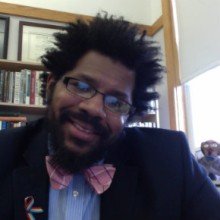
Authors /
Edward Carson
Edward Carson teaches history at the Brooks School in North Andover, Massachusetts. He is working on a book titled W.E.B. Du Bois's Editorial Influence on Western Negro Migration.
What race riots accomplish
Some riots protest injustice. Others perpetuate it.
Race on the ballot—again
In 1900, W.E.B. Du Bois named the color line as the problem of the 20th century. The color line, which still persists, is on trial this presidential election.
While Donald Trump polls low among black voters, these numbers have improved slightly.
A new series on faith in election season
At his inauguration on January 20, 1953, President Dwight D. Eisenhower took an unprecedented step: after taking the oath of office, he led the nation in prayer. During his prayer, which historian Kevin Kruse notes helped make Eisenhower’s inauguration as much a “religious consecration” as a “political ceremony,” the new president asked God to “make full and complete [the executive branch’s] dedication to the service of the people.”
Eisenhower’s professed dedication to serve all the citizens of the United States and his willingness to rely upon God’s help were not entirely new.
Obama and black politics
Roughly 94 percent of black voters now vote for a candidate from the Democratic Party. This high number at the national level may be due in part to President Obama’s racial identity. In 2008 Obama surpassed even the solidification of black votes for Lyndon Baines Johnson that occurred in 1964.
Has the United States moved closer to a post-racial society?
Confederate monuments and American citizenship
In recent years, debates over the appropriateness of public monuments celebrating Confederate figures have become increasingly common. Along with exposing deep racial divides, these debates have brought to light historical attitudes and structures built on enduring notions of white supremacy.
While generally taking place in local contexts, they have ramifications that concern all Americans.
Black scholarship speaks
The African American Intellectual History Society, founded in 2014, hosted its first annual conference last weekend at UNC Chapel Hill. Scholars from various disciplines delivered engaging papers around the theme “new perspectives on the black intellectual tradition.”
The changing nature of black identity in today’s world is complex.
The Christian campus and sexual identity
Historically, black people and those deemed “homosexual” have been marginalized and silenced on many faith-based campuses. My Then & Now post from December notes the increasing acceptance of black Christians at Christian schools. However, such acceptance has not been extended to LGBTQ Christians.
W.E.B. Du Bois’s The Souls of Black Folk intertwines “the problem of the twentieth century” color line with LGBTQ resistance in the 21st century.
The Christian campus in black and white
W. E. B. Du Bois wrote his prophetic words “the problem of the 20th century is the problem of color line” decades before the landmark Brown v. Board of Education ruling. Yet those words allowed blacks to note how the removal of Jim Crow from educational institutions was slow in many parts of the country. Often among those responsible were Christian segregationists in Christian schools and colleges.
Black atheists and the black church
As African Americans faced first slavery and then Jim Crow, they nestled in the black church as a haven. In the 1950s and ’60s, blacks congregated to fight legal oppression. In The Color of Christ, American religion historians Edward Blum and Paul Harvey argue that blacks and whites were once unified under the mantle of Christianity in efforts to combat societal vice and ills. Yet in more recent decades, black religiosity has shifted.
Though many within the black community continue to showcase their religious conservatism, others have slowly drifted away.
Changing the face of American Jesus
Brooks students entered a dated and pretentious room with the feel of an old study. They sat in a circle as they listened to Professor Edward Blum. One lecture illustration was the defaced image of Christ from after the Klan bombed the Sixteenth Street Baptist Church in Birmingham, Alabama. The room transformed as Blum’s slide showed the stained-glass window with a hole where the holy face of Christ had been.
Free Newsletters
From theological reflections to breaking religion news to the latest books, the Christian Century's newsletters have you covered.
Jesus arrives at a New England prep school
Brooks School, where I teach, is a traditional elite New England boarding school with roots in the Episcopal tradition. Founded in 1926 and named after Phillips Brooks, a well-regarded Episcopal bishop of Massachusetts, the school defies tradition as it seeks to diversify its faculty and student body. This diversity extends to its spiritual life. Its faculty represents a collection of bright, dedicated, and hardworking people. Like many academic institutions, Brooks began as a single-sex male school, and was slow to become co-educational, which transpired in 1979. New England boarding schools have long held a certain mystique among the American populace, a mystique found in films such as Dead Poets Society and in books such as John Knowles's A Separate Peace.

